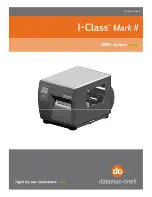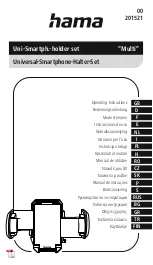
36
37
Wilma
Wilma
Deut
sc
h
Engli
sh
Operation
3
3
When you connect the light to the battery, the software runs a self-test, during which all five status LEDs
come on briefly. The
battery voltage
is then shown via the blue and green LEDs, as follows:
The blue LED blinks once for each volt; and then
the green LED blinks once for each 1/10 of a volt.
To see the battery voltage again, unplug the light from the battery and then plug it in again.
Guidelines in this regard:
More than 8.0 V: the battery is fully charged. 7.1 to 7.8 V: the battery
needs charging or is old. 6.5 to 7 V: the battery is not ready for use.
Note:
To deactivate this display, simply press the button. In other
words, you needn’t let the display go through its whole cycle in order
to use the lamp.
The Power Control System (PCS) measures the voltage under load.
Thus measurements using a voltmeter will not be comparable.
For example,
if the blue LED blinks seven times and the green LED
then blinks five times, this means that the measured voltage under
load is 7.5 V.
This display helps you to assess the actual level of the
battery prior to use.
Initialization; voltage display:
To activate the SOS function, hold the button down for three seconds and then release it. If you don’t
press the button again, the lamp will continue to emit the international SOS signal until the battery is
completely discharged. To deactivate the SOS function, press the button again. You can then use the
lamp in a normal fashion.
Note:
Use the SOS signal ONLY in an emergency. Thanks to the light’s high luminance, the signal is
visible for miles around and will continue flashing for hours if not shut off.
Improper use of the SOS
signal is punishable by law.
To switch off the lamp,
hold the button down
for more than two seconds.
Switching the lamp off:
SOS function:
Switching on/ Changing levels:
Press the power switch once to turn the light on; two blue LEDs will glow, indicating the
14W dimming level. Press the button rapidly to cycle through other power levels. Refer
to the chart on page 38-39 for the exact meaning of the five (RGB) monitor LEDs, as well
as instructions for programming options additional to the factory-set 3-step mode.
The maximum lighting output can only be achieved with enough airflow to cool the
lamp. High ambient temperature and low airflow will signal the controller to reduce
power to the LEDs, thus reducing their brightness, to avoid overheating the LEDs and
other electronics. The actual reduction is indicated by the status LEDs: e.g., after a period
of low airflow conditions, 4 of the 5 blue status LEDs will be lit, indicating that the power
has been reduced from 28W to 23W in order to protect the unit from heat damage.
Luminous performance:
Discharged battery capacity:
When you shut off the lamp, the discharged battery capacity is shown via flashing of the blue LED
and then the green LED. This information can only be displayed once as it is deleted when you
unplug the battery.
For example, if the blue LED blinks four times and then the green LED blinks six times, this means
that 4.6 Ah were discharged from the battery.
The
blue LED blinks once for each Ah (ampere hour); and then
the
green LED blinks once for each 1/10 of an Ah.











































